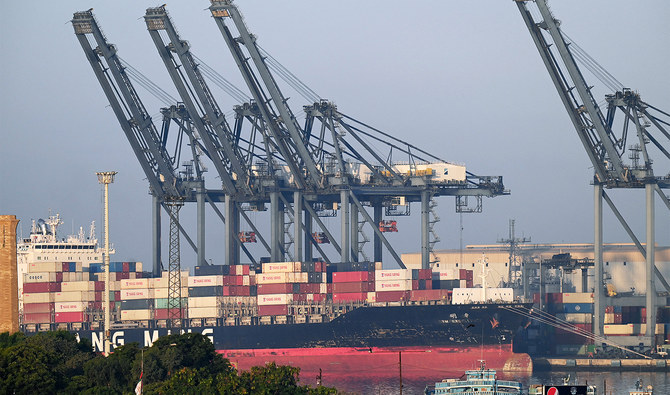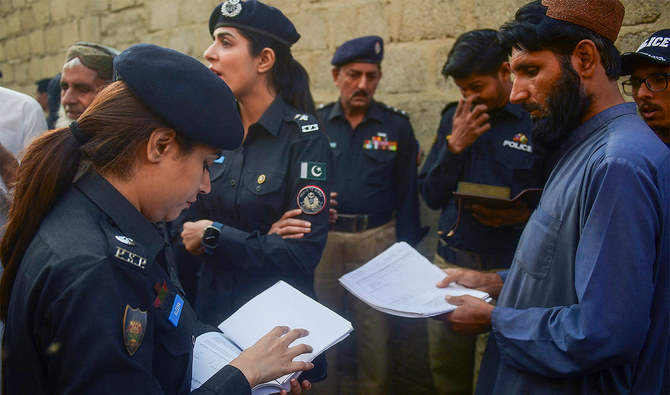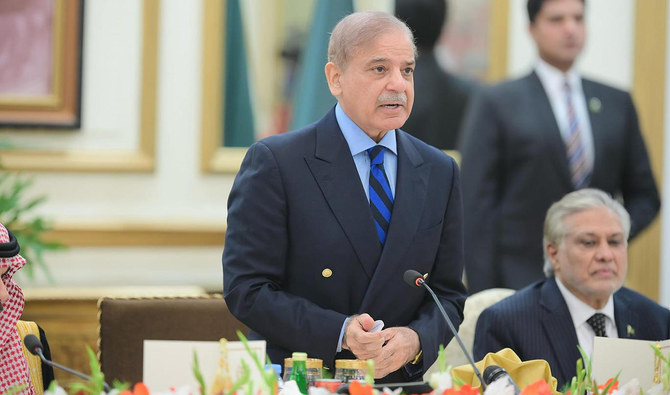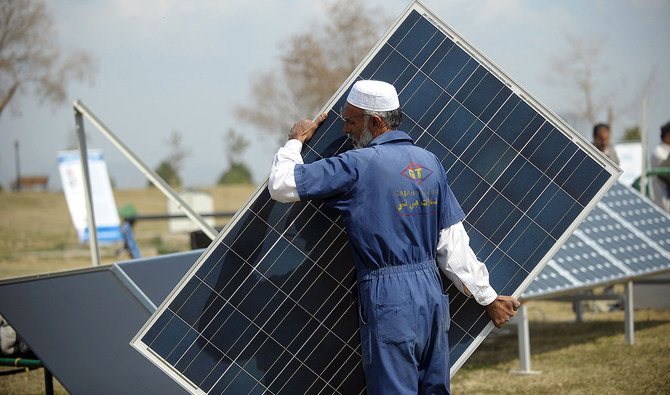KARACHI: Pakistan’s information technology and telecommunication stakeholders on Sunday called for a solution to a billing issue that recently suspended payments to Google, Amazon and Meta through cellphones after the central bank said the mechanism violated foreign exchange regulations.
Direct Carrier Billing (DCB) is an online payment method which allows users to make purchases by adding payments to their cellphone bill. The State Bank of Pakistan (SBP) said late Saturday some information technology services had been misused by cellphone operators in violation of the foreign exchange regulations.
Entities desirous of utilizing the facility designate a bank which is then approved by the SBP. Subsequently, such payments can be processed without further regulatory approval.
The central bank said in a recent statement that “Telcos [telecommunication companies] were remitting a bulk of the funds for video gaming, entertainment content etc. purchased by their customers” under the DCB in addition to utilizing the mechanism to remit funds for IT related services for their own use.
The statement added that these companies were acting as intermediaries and payment aggregators by facilitating acquisition of services by their subscribers. It added that in view of the violation of foreign exchange regulations, the SBP had revoked designation of banks for the companies for such payments.
Telecom sector experts said millions of dollars were stuck in the system due to the measure taken by the central bank since September this year.
“I think around $34 million payment has been accumulated during last one month or so,” Parvez Iftikhar, an international telecom consultant, said while talking to Arab News. “Mobile phone users will still be able to download apps from Google Play Store but they will not be able to pay for them using their mobile balance. The payments can still be made through credit cards but a majority of people don’t use them.”
Iftikhar maintained the central bank took the decision to restrict the outflow of dollar, fearing the step would also impact the country’s IT exports since freelancers and other small information technology players would not be able to pay for some of the tools and apps required.
“The value of the acquisition of such services is around $60 million annually which is negligible,” he continued while demanding an “amicable solution” to deal with the situation which was likely to impact IT exports and small technology businesses.
Zohaib Khan, Chairman of Pakistan Software Houses Association (P@SHA) said the impact of holding back the payments of global companies was hurting their trust.
“The global companies which have footfall in Pakistan are losing their trust in the country is withholding their payments,” he told Arab News, adding that his organization wanted the government to remove such hurdles to enable technology companies to freely pay and receive dollars.
“If these issues are not resolved, how will our exports increase,” he asked. “While Pakistan grapples with economic crisis, IT and information technology enabled services can potentially stabilize the country’s economy.”
Pakistan’s IT minister Amin Ul Haque also expressed his concern over the payment suspension on Saturday.
“The process of payment halt to foreign institutions may impact Pakistan’s image,” his ministry quoted him as saying.
Haque also wrote a letter to the finance minister, requesting him to ask the central bank to revisit its decision and resume payments.
Google, on the other hand, has decided to suspend the DCB services from November 30 until its outstanding payments are cleared.
The central bank, however, maintained media reports saying that the global IT giant’s payments were stuck at the State Bank were baseless and misleading.
“The SBP strongly refutes all such assertions,” it said in a statement.
Pakistani telecom experts seek solution to payment issues faced by Google, Amazon, Meta
https://arab.news/ppkdu
Pakistani telecom experts seek solution to payment issues faced by Google, Amazon, Meta

- The central bank recently revoked the direct carrier billing mechanism while saying it violated foreign exchange regulations
- Experts say payment suspension to Google, Amazon and Meta could lead to international mistrust, hurt Pakistan’s IT exports
Global logistics giant shows interest in developing Pakistan’s first green transshipment terminal

- APM Terminals sent a delegation to meet Pakistani officials and discuss the modernization of its ports
- The integrated container logistics company also develops and operates ports in countries across the world
ISLAMABAD: A delegation from a leading logistics company, A.P. Moller-Maersk (APM) Terminals, expressed interest in developing the first transshipment terminal in Pakistan while holding a meeting with Prime Minister Shehbaz Sharif on Friday.
Maersk is an integrated container logistics company operating in 130 countries. APM Terminals has been developing and operating advanced ports and container terminals for over half a century and has 60 strategically located ports and container terminals around the globe and several more in development.
The company delegation arrived in Pakistan earlier this week to discuss the possibility of developing and modernizing the South Asian nation’s ports and held separate meetings with Finance Minister Muhammad Aurangzeb and Minister for Maritime Affairs Qaiser Ahmed Sheikh.
“The prime minister expressed interest in cooperation between Pakistan and Denmark in the fields of agriculture and environment-friendly energy projects,” Radio Pakistan reported after Sharif’s meeting with the delegation led by the company CEO Keith Svendsen.
“Svendsen expressed satisfaction on the investment and business friendly policies of Pakistan,” it added. “He showed interest in the first green transshipment terminal of Pakistan in Karachi.”
The construction of the project would allow large cargo ships to utilize the Karachi port, helping the country earn greater revenue.
Previously, the country’s finance minister told the delegation Pakistan was keen to explore future projects and investments with APM, especially in the maritime sector.
“The government is fully committed to facilitate an environment conducive to business and investments,” he told them.
Svendsen and his delegation also met the maritime affairs minister on Thursday and discussed investment prospects in Pakistan’s ports and terminals sector.
“The delegation head highlighted Moller-Maersk’s prominent global position and its robust relationship with Pakistan, which reflects a market share of approximately 20 percent in containerized import-export activities,” Radio Pakistan said.
“Recognizing the immense growth potential, Keith Svendsen proposed investments to enhance integrated supply chain solutions, including the upgrading of ports and logistics infrastructure. The delegation pledged support for the advancement of maritime affairs in Pakistan and for nurturing a skilled workforce in this sector.”
On Monday, Pakistani and United Arab Emirates (UAE) officials performed the groundbreaking of a $175 million Bulk and General Cargo terminal as part of a new 25-year concession agreement signed between AD Ports Group and Karachi Port Trust (KPT) in Feb. 2024 to outsource operations of the terminal.
Under the terms of the agreement, Karachi Gateway Terminal Multipurpose Limited (KGTML), a joint venture between AD Ports Group, as a majority shareholder, and Kaheel Terminals, a UAE-based company, will develop, operate and manage the Bulk and General Cargo Terminal, berths 11 to 17 at Karachi Port’s East Wharf.
Pakistan extends Afghan refugee cards until June 30 amid deportation drive

- The drive targeting ‘illegal immigrants,’ mostly Afghan nationals, was launched last year amid security concerns
- The Pakistan government says the POR cardholders will be repatriated to Afghanistan in the third deportation phase
ISLAMABAD: The Pakistan government on Friday approved the extension of Proof of Registration (POR) cards for Afghan refugees for another two months amid an ongoing deportation drive against unregistered foreigners in the country.
POR cards are identification documents issued by Pakistani authorities to Afghan refugees. These cards serve as official recognition of the refugees’ legal status in the country, allowing them to access various services such as education, health care and banking.
The Pakistan government extends these cards on a periodic basis, often depending on the political and security situations involving both countries. The extension of these cards is typically subject to review by the Pakistani government, in consultation with international organizations like the United Nations High Commissioner for Refugees (UNHCR).
“The federal cabinet has approved the extension of the validity of Proof of Registration cards for Afghan refugees from April 1, 2024, to June 30, 2024, on the recommendation of SAFRON [the Ministry of State and Frontier Regions],” announced an official statement issued after the cabinet meeting.
“The cabinet was informed that this extension would allow POR cardholders to benefit from facilities such as schools, bank accounts and other services in Pakistan,” it added. “These POR cardholders will be sent back to their home countries in the third phase of the program for repatriating foreigners residing illegally in Pakistan.”
Pakistan initiated a deportation drive targeting “illegal immigrants,” predominantly Afghans, late last year, citing security concerns amid a spike in militant attacks.
The move stirred unease among registered Afghan refugees, many of whom pointed out they were anxious about their uncertain future.
Pakistani officials have attributed several lethal attacks on both security forces and civilians to Afghan nationals, expressing their commitment to repatriate all Afghan refugees, including many born in Pakistan to families who settled during the 1980s following the Soviet invasion.
The Afghan authorities in Kabul have objected to the deportation drive, disputing that Afghan nationals had any role in the ongoing security deficit in Pakistan.
They have also maintained that Pakistan should have consulted them over the issue and given more time to Afghan nationals before sending them back to their country.
Pakistan PM to attend WEF meeting in Riyadh from April 28-29 — foreign office

- PM Sharif is expected to discuss inclusive growth, regional collaboration and energy issues at the gathering
- He will also attend the Islamic Summit Conference in Gambia on May 4 to discuss Islamophobia and Palestine
ISLAMABAD: Prime Minister Shehbaz Sharif is scheduled to visit Saudi Arabia on the invitation of Crown Prince Mohammed bin Salman to attend a two-day World Economic Forum (WEF) meeting in Riyadh starting April 28, the foreign office of Pakistan said on Friday.
The two countries share cordial relations and have witnessed high-level official exchanges in recent years to further consolidate their ties, with Saudi foreign minister Prince Faisal bin Farhan visiting Pakistan earlier this month to discuss a spectrum of issues with the administration in Islamabad.
Prior to that, the Pakistani prime minister met the Saudi crown prince in Makkah to discuss the kingdom’s commitment to expedite its investments worth $5 billion.
“Prime Minister Muhammad Shehbaz Sharif and Foreign Minister Mohammad Ishaq Dar will attend the World Economic Forum Special Meeting on Global Collaboration, Growth and Energy to be held in Riyadh, Kingdom of Saudi Arabia, from 28-29 April 2024,” foreign office spokesperson, Mumtaz Zahra Baloch, said during her weekly media briefing.
“They have received the invitations from HRH Muhammad bin Salman bin Abdulaziz Al-Saud, Crown Prince and Prime Minister of the Kingdom of Saudi Arabia and Professor Klaus Schwab, the Founder and Executive Chairman of the World Economic Forum,” she continued.
Baloch said the occasion would allow the Pakistani delegation to interact with foreign leaders and heads of international organizations.
“The high-level participation in the Forum will afford an important opportunity to present Pakistan’s priorities specifically in global health architecture, inclusive growth, revitalizing regional collaboration and the need for striking a balance between promoting growth and energy consumption,” she added.
The prime minister will also attend the 15th session of the Islamic Summit Conference organized by the OIC on May 4-5 in the Gambian capital of Banjul to discuss a variety of regional and global issues, including Palestine, Islamophobia, climate change and the status of minorities, state-run APP reported.
The session will be held under the slogan “Enhancing Unity and Solidarity through Dialogue for Sustainable Development,” according to a press release issued by the OIC General Secretariat.
The Islamic Summit Conference attended by Sharif will be preceded by a preparatory meeting of senior officials on April 30 and May 1, who will discuss the documents of the session and submit a report to a preparatory meeting of the Council of Foreign Ministers (CFM).
“The preparatory CFM meeting will be held on May 1-2 to consider the results of the senior officials meeting and in turn, submit its report to the Summit,” the OIC said.
“Leaders of the member states will discuss the political issues of the Islamic world, most notably the Palestinian cause, and the economic, humanitarian, social and cultural issues, in addition to the issues of youth, women, family, science and technology, information, Muslim communities and minorities in non-OIC member states, and legal matters,” the OIC said.
The Summit will also tackle issues related to hate speech and Islamophobia, the promotion of dialogue, climate change and food security.
“The 15th session will issue a final communique that includes the OIC positions on the issues submitted to the Summit, a resolution on Palestine and Al-Quds Al-Sharif, and the Banjul Declaration,” the OIC added.
The Islamic Summit is a principal organ of the OIC focused on the formulation, development, and implementation of decisions made by 57 member states. The Summit is attended by concerned heads of state such as prime ministers, presidents, emirs and other equivalent heads.
Demand for solar power rises in Pakistan as import glut crashes panel prices

- Businessmen say solar panel prices have dropped by over sixty percent due to bulk import, rate cuts by China
- Islamabad currently only generates around five percent of its energy from renewable solutions like solar power
ISLAMABAD: The price of solar panels has plummeted by over sixty percent in Pakistan in recent weeks due to bulk imports from China because of lower rates, importers said this week, with more consumers switching to the renewable source of power to reduce electricity bills.
The cost of producing solar panels in China, which accounts for about 80 percent of global consumption, plummeted by 42 percent in the last year, giving manufacturers there an enormous advantage over rivals in places like the United States and Europe. Multiple European solar manufacturers have announced plans to close factories in recent months, under price pressure from Chinese imports. China accounts for 80 percent of solar module production capacity after years of subsidies.
Pakistan has ideal climatic conditions for solar power generation, with over nine hours of sunlight in most parts of the country. Utilizing just 0.071 percent of the country’s area for solar photovoltaic (solar PV) power generation would meet Pakistan’s electricity demand, according to the World Bank.
But currently, only 5.4 percent of Pakistan’s installed power generation capacity of 39,772 megawatts comes from renewables like wind, solar and biomass, while fossil fuels still make up 63 percent of the fuel mix, followed by hydropower at 25 percent, according to the National Electric Power Regulatory Authority (NEPRA).
But this may change with an acute drop in the price of panels, importers said.
“A solar plate of 580 watts that I bought [last year] for 75,000 rupees [$270] has dropped to 25,000 rupees [$90] now,” Muhammad Yahya, a solar importer in Islamabad, told Arab News on Thursday. “That means it’s one-third of [earlier price].”
“The rates of the inverters are the same and keep fluctuating, but the main thing is solar panels and the rates of the solar panels are now 33 percent lower.”
Prices of solar panels dropped in China following import curtailment from major buyers including India, US and Europe while the Pakistani government had abolished a 17 percent sales tax to encourage solar imports, Yahya said, explaining the reduction in panel prices:
“People who would import through illegal channels, they [the government] blocked them, this helped stop the illegal import, and led to a bulk import, and secondly the rates [of solar panels] have dropped in China.”
Another solar panel importer in Islamabad, Abdul Moiz, agreed that the rate drop in China and curtailment of imports to India and other major buyers had led to bulk imports to Pakistan.
“America and India have stopped their imports [from China], that’s why the majority of the imports are now directed toward Pakistan,” Moiz told Arab News.
“CLIMATE CHANGE”
Despite the benefits, including to the environment of zero carbon emissions from solar panels, Pakistan is far behind in meeting its goal of shifting to 60 percent renewable energy by 2030 with 50 percent reduction in projected emissions.
Experts say procedural and bureaucratic delays in construction approvals and unattractive tariffs for selling power to the national grid coupled with a lack of political will and little government investment had blocked the progress of the solar industry in the past. For households, a big impediment, before the Chinese rate cuts, was the steep initial investment.
But that has changed, with electricity consumers describing the drop in solar panel prices as a ‘big relief’ in reducing their electricity bills.
“After its [solar panel] installation, our [electricity] cost has reduced to thirty percent,” Imran Ali Gul, a manager at a local hotel who has installed a 16kw system, told Arab News. “That’s why we preferred to get the solar system installed.”
Aamir Hussain, chairman Pakistan Alternative Energy Association, told Arab News Pakistanis purchased and installed solar panels of around 1800 megawatts last year, which was expected to jump to 3,000 megawatts this year due to the lower prices of the panels and increased customer demand.
“Pakistan will be spending over $3.5 billion [this year] on solar panels imports only as this doesn’t include import of batteries, inverters and other auxiliary items,” Hussain said. “Pakistan needs to follow consistent policies regarding renewable energy to meet its national and international obligations for the greenhouse gas emissions.”
Experts also said Pakistan, one of the most vulnerable nations to climate change impacts, needed to swiftly move to end its reliance on fossil fuels.
“There is no denying of the fact that climate change has wreaked havoc globally, so the studies suggest that in order to meet the global targets of reducing our temperature etc, in addition to transition of existing fossil fuel power plants, we should cap these fossils as well,” Manzoor Ahmed, a researcher at the Policy Research Institute for Equitable Development in Islamabad, told Arab News.
“So, given this roadmap, given our commitments in terms of net zero emissions or COP conferences where we agreed to meet global targets, we have no choice but to shift to renewables and we must do it.”
Pakistani driver bags first-ever top 4 finish at Dubai Nations Cup

- Enaam Ahmed, 24, was born to Pakistani parents in London, started racing on Go-Kart tracks at age eight
- Ahmed became a British Formula Champion at 12 and a European and World Champion at the age of 14
ISLAMABAD: British-Pakistani racer Enaam Ahmed achieved a ground-breaking milestone this week by securing Pakistan’s first-ever top 4 finish at the Nations Cup in the Dubai 12-Hour Endurance Karting Race.
Ahmed, 24, was born to Pakistani parents in London where he started racing on Go-Kart tracks while he was eight. His passion grew with time, and he ultimately became the British Formula Champion at 12 and a European and World Champion at the age of 14. He is currently in the American Formula 3 league, before which he was car racing in the British Formula 3 and became a champion at 17.
For the Dubai tournament, Ahmed told Pakistan’s Geo News he chose the “two most talented drivers from Pakistan” to make team Pakistan, namely Maz Chughtai and Shamiq Saeed.
In the qualifying round, Pakistan managed to secure 2nd place in the Nations Cup and 4th overall against 30 of the best endurance teams from around the world. Team Pakistan then delivered a historic top-4 finish, but also won over archrivals India with an impressive 9-lap lead even after dropping to 30th place due to an unlucky puncture.
“It’s an honor to represent Pakistan and to achieve this milestone alongside my teammates,” he told reporters. “We worked tirelessly to make our country proud, and to also secure a commanding victory over India adds an extra layer of satisfaction to our accomplishment … This victory not only underscores Pakistan’s prowess in motorsports but also opens a new chapter whereby a new generation of drivers will be inspired.”
Speaking to Arab News in an interview in 2022, Ahmed said what inspired him was a desire to “change the way the world perceives our country [Pakistan] and the Muslim world, in terms of sports.”
“Representing the country [Pakistan] is what gives me the power, what gives me the motivation to succeed ... What keeps me going is this burning ambition to prove that we can be the best.”
While Ahmed has traveled and raced in some top teams and against some of the best drivers in the world, he also had to face racism initially as a rare person of color alongside the black British driver, Lewis Hamilton, who had inspired him to enter the profession in the first place. Ahmed has also found it difficult to find good sponsors, which he said was the reason he missed the chance of getting into Formula 2 in Europe.
“There were moments when I didn’t want to give up but it was looking like I would have to give up because there was no option,” he said. “There were some situations when I didn’t have a sponsor one week before a race, but I always found a way.”
Despite the odds, there has been no looking back for Ahmed, who has never lost a race and always finishes in the top three.
“I have always done things to be the best or nothing,” he said. “I don’t do things just to take part or come second or third. I am here to win.”
Speaking about his special connection with Pakistan, he said he was “put on this earth to race for Pakistan and become a champion.”
“I have two biggest motivations: One is to make my country proud and raise the flag of Pakistan the highest it has ever been, and to relieve my parents, my family of work.”
Ahmed is also on the Road to Indy series, a racecar driver development program that provided a scholarship-funded path to reach the IndyCar Series and Indianapolis 500.










